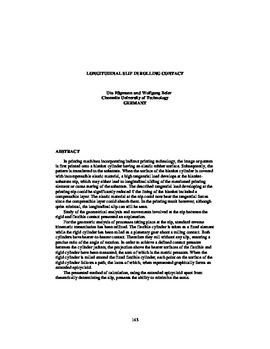| dc.contributor.author | Fugmann, Uta | |
| dc.contributor.author | Beier, Wolfgang | |
| dc.contributor.other | International Conference on Web Handling (2013) | |
| dc.date.accessioned | 2019-11-12T14:57:38Z | |
| dc.date.available | 2019-11-12T14:57:38Z | |
| dc.date.issued | 2013-06 | |
| dc.identifier | oksd_icwh_2013_fugmann | |
| dc.identifier.citation | Fugmann, U., & Beier, W. (2013, June). Longitudinal slip in rolling contact. Paper presented at the Twelfth International Conference on Web Handling (IWEB), Stillwater, OK. | |
| dc.identifier.uri | https://hdl.handle.net/11244/322021 | |
| dc.description.abstract | In printing machines incorporating indirect printing technology, the image or pattern is first printed onto a blanket cylinder having an elastic rubber surface. Subsequently, the pattern is transferred to the substrate. When the surface of the blanket cylinder is covered with incompressible elastic material, a high tangential load develops at the blanket-substrate nip, which may either lead to longitudinal sliding of the mentioned printing element or cause tearing of the substrate. The described tangential load developing at the printing nip could be significantly reduced if the lining of the blanket included a compressible layer. The elastic material at the nip could now bear the tangential forces since the compressible layer could absorb them. In the printing result however, although quite minimal, the longitudinal slip can still be seen. | |
| dc.description.abstract | Study of the geometrical analysis and movements involved at the nip between the rigid and flexible contact presented an explanation. | |
| dc.description.abstract | For the geometric analysis of processes taking place at the nip, standard reverse kinematic transmission has been utilized. The flexible cylinder is taken as a fixed element while the rigid cylinder has been rolled as a planetary gear about a rolling contact. Both cylinders have bearer-to-bearer contact. Therefore they roll without any slip, ensuring a precise ratio of the angle of rotation. In order to achieve a defined contact pressure between the cylinder jackets, the projection above the bearer surfaces of the flexible and rigid cylinder have been measured, the sum of which is the metric pressure. When the rigid cylinder is rolled around the fixed flexible cylinder, each point on the surface of the rigid cylinder follows a path, the locus of which, when represented graphically forms an extended epicycloid. | |
| dc.description.abstract | The presented method of calculation, using the extended epicycloid apart from theoretically determining the slip, presents the ability to minimize the same. | |
| dc.format | application/pdf | |
| dc.language | en_US | |
| dc.publisher | Oklahoma State University | |
| dc.rights | In the Oklahoma State University Library's institutional repository this paper is made available through the open access principles and the terms of agreement/consent between the author(s) and the publisher. The permission policy on the use, reproduction or distribution of the article falls under fair use for educational, scholarship, and research purposes. Contact Digital Resources and Discovery Services at lib-dls@okstate.edu or 405-744-9161 for further information. | |
| dc.title | Longitudinal slip in rolling contact | |
| osu.filename | oksd_icwh_2013_fugmann.pdf | |
| dc.type.genre | Conference proceedings | |
| dc.type.material | Text | |
